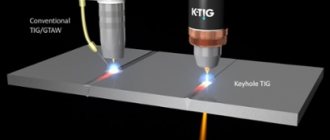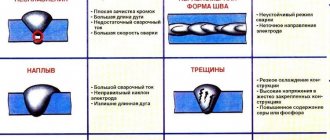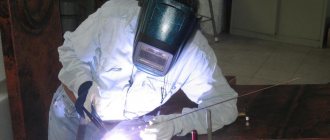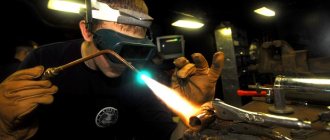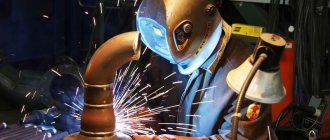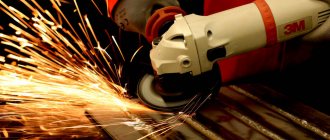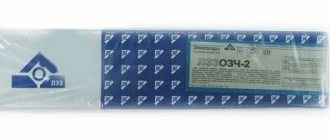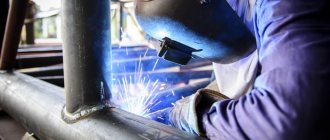The profession of electric and gas welder is widespread and highly paid. It is readily chosen by students of specialized educational institutions. Before starting work in the profession, an employee must familiarize himself with his responsibilities and undergo training on labor protection. Basic information regulating working issues is contained in the job description of an electric gas welder. This is exactly what we are compiling below.
- Form and sample
- Free download
- Online viewing
- Expert tested
FILES
Sample job description for electric and gas welder
General provisions
An electric gas welder must know:
- features of cutting and welding rules;
- device and features of using welding machines;
- rules for operating the equipment with which he will work;
- sequence of applying and grouting joints;
- technological features of the materials with which he will work;
- norms and rules of work in force at the enterprise;
- fire safety rules and handling of fire extinguishing agents;
- the main provisions of the labor protection instructions.
Job responsibilities of an electric and gas welder
The electric and gas welder is obliged to:
- carry out preparatory work before welding;
- grout joints;
- check and adjust equipment necessary for work;
- understand the structure of gas cylinders;
- be able to choose the brand of electrodes for a specific type of metal;
- know the types of electrodes;
- be able to read drawings;
- be able to read electrical diagrams and know the structure of the welding machine;
- set the optimal welding mode;
- perform welding work, tack welding of structural elements, smelting, arc cutting of simple parts;
- eliminate metal surface defects that appear after welding work;
- control the design standards specified in the drawings;
- participate in events that improve the level of his qualifications;
- take part in briefings regarding fire safety and labor protection rules;
- undergo a medical examination during the period designated by the employer;
- do not violate the work regime established in the organization;
- know the causes of defects on metal and be able to get rid of them;
- be able to apply a vertical suture.
Rights of an electric and gas welder
An electric gas welder has the right:
- demand from the employer to provide working conditions that comply with the norms of current legislation;
- put forward proposals regarding optimization and improvement of working conditions;
- ask management to provide the necessary inventory and equipment for work;
- consult with management and ask for assistance in performing your duties;
- study management orders regarding changes in the specifics of its activities;
- inform management about shortcomings identified in the process of carrying out its activities;
- request documents and materials required for the implementation of his professional activities;
- improve the level of his or her existing qualifications;
- demand that management provide free work clothes and shoes;
- involve other site employees to resolve tasks set by the manager;
- receive compensation in the event of a work-related injury for the costs incurred for treatment and subsequent rehabilitation.
4. Responsibility of the employee
The manager has the right to impose a disciplinary sanction on an employee for:
- violation of Russian labor legislation;
- violation of labor standards established by the company;
- intentional damage to the employer’s property or causing other types of damage provided for by the norms of the current legislation of the Russian Federation;
- committing offenses at the enterprise that do not fall within the scope of the Criminal or Administrative Codes of the Russian Federation;
- appearing at the workplace under the influence of alcohol, drugs or other forms of intoxication;
- refusal to submit to your immediate supervisor.
Characteristics of the work.
Manual arc and plasma welding of medium complexity of machine parts, assemblies, structures and pipelines made of structural steels, cast iron, non-ferrous metals and alloys and complex parts, assemblies, structures and pipelines made of carbon steels in all spatial positions of the weld. Manual oxygen cutting (planing) of complex parts made of high-carbon, special steels, cast iron and non-ferrous metals, welding of cast iron structures. Fusion of heated cylinders and pipes, defects in machine parts, mechanisms and structures. Welding of complex parts, assemblies and complex tools. Reading drawings of complex welded metal structures.
Document correction and approval
Changes to the job description are made by mutual agreement of the parties, unless otherwise provided by the terms of the enterprise charter or the labor agreement concluded between the employee and the employer.
Changes are made to the document at least once every five years (from the moment the parties sign this DI), however, at the request of the parties, changes can be made earlier, after preliminary approval.
The job description is certified by the signatures of the applicant applying for the position of electric and gas welder, and the employee supervising the personnel selection process (HR specialist, department head, enterprise director, etc.).
Explanations for the job description
The job description consists of four main points:
- General provisions.
- Job responsibilities.
- Electrical and gas welder's rights.
- Responsibility of an employee in case of improper performance of work schedule.
General provisions
General provisions are included in the document based on local standards. The personal information of the immediate supervisor of the electric and gas welder must be indicated. Equally important is the note about which employee will replace him during his absence. This information is indicated at the very beginning of the instructions before its contents.
Qualification requirements are prescribed in the first or second sections of the job description.
Qualification requirements are included in the job description taking into account the employee’s rank. If an electric gas welder has to work with mechanical welding, this will be reflected in the job description. If the employee will be engaged in manual welding, then it is necessary to indicate its type:
- gas;
- plasma;
- arc.
The job description items are drawn up as informatively as possible. The clearer the wording, the easier it is for the employee to understand it. If the electric and gas welder fails to cope with his duties, then it will be easier for the employer to make justified claims by pointing to the corresponding point in the job description.
Responsibilities
All job responsibilities of an electric and gas welder must be specified. If any point is not reflected in the instructions, then the employer does not have the right to apply disciplinary action to the employee for failure to fulfill his duties.
Employee rights
This section reflects the rights of the employee at the place of his employment. The employee has the right to receive free work clothes and shoes. He can turn to management to resolve problems that have arisen and receive all kinds of assistance from him. It is also legal for an employee to receive compensation if he or she is injured at work. This clause is intended to resolve disputes arising due to the fault of the employer.
Compensation is not provided to an employee if he was injured as a result of negligence or improper performance of his duties.
Responsibility
An employee is held accountable under the legislation of the Russian Federation if his actions pose a threat to others or the organization in which he works. An electric and gas welder can be brought to various types of liability, including criminal liability. The purpose of this paragraph is to resolve disputes between the parties arising as a result of unlawful actions of an electric and gas welder in the workplace.
An electric gas welder is not a fully financially responsible person. If he causes damage, the manager will not be able to recover from him an amount equal to his average monthly earnings. This norm is regulated by the current legislation of Russia.
The manager endorses the document with his signature; it is not necessary to put a stamp on the instructions. The electric and gas welder must sign in a special journal, confirming that he has familiarized himself with the contents of the DI.
Work examples
1. Apparatuses, vessels, containers made of carbon steel, operating without pressure - welding. 2. Reinforcement of load-bearing reinforced concrete structures - welding. 3. Transformer tanks - welding of pipes, welding of terminal boxes, cooler boxes, current installations and tank covers. 4. Rudder stocks, propeller shaft brackets - welding. 5. Fittings and boiler burner bodies - welding. 6. Cast iron parts - welding, fusion with and without heating. 7. Chambers of hydraulic turbine impellers - welding and surfacing. 8. Frames of industrial furnaces and boilers DKVR - welding. 9. Engine crankcases - welding. 10. Gas exhaust manifolds and pipes - welding and welding. 11. Hydraulic turbine control rings - welding and deposition. 12. Housings and axles of the header drive wheels - welding. 13. Compressor casings, low and high pressure cylinders of air compressors - crack fusion. 14. Rotor housings with a diameter of up to 3500 mm - welding. 15. Stop valve housings for turbines with power up to 25,000 kW - welding. 16. Fastenings and supports for pipelines - welding. 17. Brackets and pin fastenings of the diesel locomotive bogie - welding. 18. Sheets of large thickness (armor) - welding. 19. Masts, drilling and production rigs - welding in workshop conditions. 20. Struts, axle shafts of aircraft landing gear - welding. 21. Foundation slabs of large electrical machines - welding. 22. Dust-gas-air ducts, fuel return units and electric precipitators - welding. 23. Transformer frames - welding. 24. Bed frames - welding in a rotary jig in all spatial positions, except for the ceiling. 25. Tanks for petroleum products with a capacity of less than 1000 cubic meters. m - welding. 26. Rails and prefabricated crosspieces - fusing ends. 27. Stators of air-cooled turbogenerators - welding. 28. Crusher beds - welding. 29. Welded-cast frames and housings of electrical machines - welding. 30. Beds of large-sized cast iron machines - welding. 31. Beds of working stands of rolling mills - surfacing. 32. Pipelines of external and internal water supply and heating networks - welding during installation. 33. Pipelines of external and internal low-pressure gas supply networks - welding in stationary conditions. 34. Technological pipelines (V category) - welding. 35. Complex cutters and dies - welding and surfacing of high-speed cutters and hard alloys. 36. Frameworks, connections, lanterns, purlins, monorails - welding. 37. Car block cylinders - fusing of shells. 38. Car tanks - welding. Electric arc welding 1. Fittings, pipelines, branches, flanges, fittings, cylinders, tanks, tanks made of carbon steels operating under pressure of 1.5 to 4.0 MPa (from 15 to 40 kgf/sq. cm) - welding. 2. Beams and traverses of crane trolleys and mechanisms - welding. 3. Lugs, flanges, welds, fittings for high-pressure compressor cylinders - welding. 4. Cylinders, tanks, reservoirs, tanks, separators, filters, evaporators made of carbon steel - welding under pressure from 0.1 to 1.5 MPa (from 1 to 15 kgf/sq. cm). 5. Reflective tanks made of low-carbon steel with a thickness of 1.0 to 1.5 mm - welding in the lower position. 6. Banquettes, shaft housings, winch housings, winch gear housings, deck glasses - welding under pressure from 0.1 to 1.0 MPa (from 1 to 10 kgf/sq. cm) in the lower position. 7. Block sections - welding of baffles, saturation to the body. 8. Waterline beads - welding along the ship’s hull. 9. Medium-sized crankshafts - welding and fusing of worn parts. 10. Propellers, blades, hubs of normal accuracy class of all sizes and designs - air-arc planing of all surfaces. 11. Fences, bulkheads and deckhouses - welding and welding in various spatial positions. 12. Gas exhausts, air distributors, ventilation pipes in the superstructure - welding. 13. Silencers for high-pressure compensators, steel, metal thickness 1.5 mm and diameter up to 100 mm - welding. 14. Doors and hatch covers are water-gas-tight - welded. 15. Bottom, side, upper and lower decks, platforms, volumetric sections of ends, transverse and longitudinal bulkheads - welding of frame joints on a slipway. 16. Metalwork details for the main body and lining of the main tanks - welding. 17. Shelf parts - welding to intercompartment transverse bulkheads. 18. Doors, panels, angles, sheets, bushings with a metal thickness of 1.4 to 1.6 mm - welding. 19. Parts of complex configuration, intended for work under dynamic and vibration loads, material thickness from 10 to 16 mm - welding. 20. MSCh products - anti-corrosion deposits of AK type steels on surfaces for machining. 21. Casings, gutters, panels, pallets made of carbon and low-alloy steels up to 2 mm thick, alloy steel over 2 mm thick - welding. 22. Cable boxes - welding under pressure testing from 0.1 to 1.5 MPa (from 1 to 15 kgf/sq. cm) during unit assembly. 23. Casings, gutters, panels, pallets made of carbon and low-alloy steels up to 2 mm thick, alloy steel over 2 mm thick - welding. 24. Ship ventilation ducts - welded to bulkheads on the slipway. 25. Anchor fairleads - welding. 26. Casings, gutters, panels, pallets made of alloy steel up to 2 mm thick - welding. 27. Ventilation valves - welding. 28. Cargo hold coamings - welding of the set together. 29. Body structures made of carbon, low-alloy and high-alloy steels - air-arc gouging in hard-to-reach places (melting the weld root, removing temporary elements, smelting defective areas). 30. Ship-carrying train structures - welding. 31. Hull of a surface vessel: outer deck plating - welding of joints and grooves on the slipway in all positions. 32. Hulls of heavy portholes - welding and welding into the ship’s hull. 33. Hull structures and assemblies, up to 20% of the welds of which are subjected to ultrasonic or gammagraphic control - welding. 34. Brackets, edges, screens made of sheet and profile metal up to 2 mm thick - welding. 35. Caps and bearing housings made of castings - welded for tightness testing. 36. Removable sheets made of carbon and low-alloy steels - welding. 37. Recess marks, cargo welding - welding to the ship’s hull. 38. Masts, cargo booms, cargo columns - welding of assembly joints and face sheets on the slipway. 39. Signal masts - welding during assembly. 40. Metal structures of ships - welding of defective areas of seams when tested on a slipway and afloat in all positions. 41. Intercompartment transverse bulkheads - welding. 42. Saturation of fittings and hulls - welding on the transverse and longitudinal bulkheads of the superstructure. 43. A set of longitudinal and transverse bottom, side and deck (calculation) sections made of structural steel - welding to each other and welding to the outer plating and deck flooring on pre-stall assembly. 44. Set with grooved edges, joints and grooves of steel bulkheads - assembly and welding at the pre-assembly site. 45. A set of bottom sections with a height of 0.8 to 1.5 m - welding at the bow end, to the bottom flooring and welding to each other. 46. Superstructures, deckhouses made of alloy steels - welding and welding to the main body. 47. Double bottom decking - welding joints and grooves on the slipway. 48. Saturation of cargo masts, booms (heads, foundations, control platforms with railings) - welding to structures. 49. Butts for transporting sections with a lifting capacity of up to 20 tons - welding and welding to sections. 50. Butts with a lifting capacity of over 20 tons - welding and welding. 51. Steel rudder blade - welding of the flat part. 52. Transverse and longitudinal bulkheads, external walls of superstructures - welding of joints and grooves of panels in all positions on the slipway. 53. Reinforcements for foundations, construction device supports, side keels, outer walls of tanks, outer walls of a chimney - welding on a slipway. 54. Other tanks - welding of seams with grooved edges and structural lack of penetration on sectional assembly. 55. Rails of workshop electric trolleys - welding. 56. Joints and grooves of the aft end skin, brackets and stabilizers - welding. 57. Joints of sheets of walls, roofs and a set of internal tanks - welding and welding to the casing, bulkheads and to each other. 58. Assembly joints of reinforced concrete vaults - welding. 59. Tambour, airlock, bathrooms - welding and welds. 60. Ship ventilation pipes made of carbon and low-alloy steels up to 2 mm thick - welding and welding of flanges to them. 61. Pipelines made of carbon steels operating under pressure from 0.1 to 1.5 MPa (from 1 to 15 kgf/sq. cm), with a pipe wall thickness of over 2 mm - welding. 62. Pipelines - welding of joints on backing rings with quality control of the seams by radiography. 63. Pipelines - welding of pressurized joints with quality control of seams by radiography. 64. Anchor, towing, launching and mooring devices, construction device stops - welding. 65. Flanges, pipes, fittings, welds, nozzles, nipples - welding to the pipeline under pressure from 0.1 to 1.5 MPa (from 1 to 15 kgf/sq. cm). 66. Foundations made of alloy steel for auxiliary mechanisms, cylinders, boat and mooring devices - welding. 67. Frames - welding of joints during heat treatment in a high-frequency high-frequency installation. 68. Dies for presses with pressures over 400 tons - welding. Welding in shielding gases 1. Tin bronze fittings under pressure from 0.1 to 1.5 MPa (from 1 to 15 kgf/sq. cm) - fusing of exposed defects in castings after machining. 2. Fittings, casting, parts made of aluminum-magnesium alloys - welding, welding of defects. 3. Fans - welding of disks with a brush made of aluminum alloys. 4. Views made of non-ferrous alloys - welding. 5. Flame pipe heads, aluminum alloy flame pipe - welding. 6. Gas exhausts, mufflers made of stainless steel, copper-nickel alloys - welding. 7. Silencers for high-pressure compressors made of aluminum alloys with a metal thickness of 2 to 3 mm - welding. 8. Details of saturation of the aluminum alloy body - welding in the ceiling position. 9. Parts and assemblies made of aluminum-magnesium alloys of medium complexity, operating under pressure from 0.1 to 1.0 MPa (from 1 to 10 kgf/sq. cm) - welding. 10. Parts and components of current distribution devices made of aluminum alloys: hermetic boxes, shells, angles, hinges, cans, brackets, racks, frames, shoulders, welds, gaskets, grooves - welding to the body and welding. 11. Hull structures after hydraulic tests - tacking, welding, correction of seam defects; binding of temporary fastenings. 12. Rings and branches of pipe sections made of non-ferrous alloys under pressure from 0.1 to 1.5 MPa (from 1 to 15 kgf/sq. cm) - welding. 13. Structures made of aluminum, titanium and non-ferrous alloys - welding of holes, tack welding in vertical and ceiling positions. 14. Impellers, flanges, covers of electrical appliances made of aluminum alloys - welding of cracks, binding of broken parts. 15. Alloy structures - tack in all spatial positions. 16. Structures made of aluminum and titanium alloys - straightening using the method of applying blank rollers. 17. Composite structures (steel - aluminum alloy) - welding using bimetallic inserts. 18. Masts made of aluminum alloys - welding of joints and grooves of the mast barrel and welding of components. 19. Superstructures, deckhouses made of aluminum alloys - welding of volumetric units, set joints at intersections. 20. Castings with a wall thickness of up to 10 mm - welding of shells and cracks under pressure testing of 0.1 to 1.0 MPa (from 1 to 10 kgf/sq. cm). 21. Castings from aluminum alloys - welding of defects. 22. Castings with a wall thickness of over 10 mm, operating under pressure over 1.0 MPa (10 kgf/sq. cm) - welding of defects. 23. Hydraulic cylinder pistons and other products (hooks of anchor devices, winch seals) - cladding with copper alloys. 24. Frames, sashes made of non-ferrous metal - welding of incoming parts. 25. T-joints - with full penetration of the outer skin sheet made of aluminum alloys. 26. Joints of pipes not working under pressure, made of aluminum and non-ferrous alloys - welding of rotary joints. 27. Vertical and inclined ladders made of aluminum alloys - welding. 28. Reinforcement units made of non-ferrous metals - welding of parts, welding of parts under pressure from 0.1 to 1.5 MPa (from 1 to 15 kgf/sq. cm). 29. Flanges, rollers, housings, boxes, covers, blocks - fusing and welding with bronze, alloys, corrosion-resistant steels. 30. Foundations for mechanisms and instruments - editing. 31. Seams after automatic welding in shielding gases - making fillets and finishing rollers. 32. Alloy scuppers - welding. 33. Copper busbar with a metal thickness of 12 mm - welding with preheating of the metal. Cost and terms
